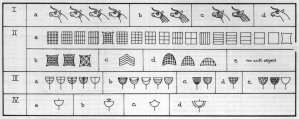  |
Clay relief stamped
with the figure of the Babylonian hero Gilgamesh, holding a vase from which two streams of
water flow. (British Museum No. 21204) Fragment
of limestone sculptured in relief with vases from which streams of water flow. (British
Museum No. 95477) [Leonard W. King, 1916, A History of Sumer and Akkad, London,
Chatto and Windus, p.73) |
 
|
Engraved shell
plaques, Telloh, 3rd millennium B.C. (London)[Note the trident, spears and the lion biting
into the neck of the one-horned bull] Animals
depicted on a gaming board (Mesopotamia) |
 |
Group 1:
hatched face animal (with zig-zag or straight cage on the standard) is associated with the
north, around Harappa and the Sarasvati river Group 2: (with collared necks and straight
cage on the standard) is found in the south, around Mohenjodaro
cf. Rissman, 1989: 168. |
 |
Decorations on the
head and neck of the 'unicorn' |
 |
Three groups of
'unicorn' seals; cf. Franke-Vogt 1992: fig. 13.3 |
 |
Inscribed copper
tablet DK 11307 Mohenjodaro. Conjoined bovids (with 'unicorn' stripes on the face) with
two 'altars' in front. Four signs on reverse. (Jansen and Urban, 1987, p. 71). [The
stylised pannier on the bovids is an indicator that a 'unicorn' (ibex/urus) is depicted
with two horns. The 'altars' may be 'troughs' which normally appear in front of other
animal pictorials such as the bison, tiger, elephant or rhinoceros.] |
 |
Cylinder seal impression, Tell as-Sulema,
Mesopotamia, level IV (Akkadian to Early Old Babylonian)(IM 87798); gypsum; length 2.6
cm., dia. 1.6 cm. Drawing by Lamia Al-Gailani Werr; cf. Collon 1987: 143, no. 609;
Parpola, 1994, p. 181; bird over a unicorn; fish over a bison. |
  |
Cylinder seal; Louvre,
ca. 3000 B.C |
 |
Cylinder seal; Louvre,
ca. 3000 B.C. (Sumerian seal from Jemdet Nasr showing 13 'unicorns'; cf. Heras, 1953, p.
220). |
 |
Standard of Ur
depicting the one-horned bull and other scenes. |


|
Ram's body and the
elephant's trunk; SD 1109; Stone statue; Mohenjodaro Museum 430 (H 25.5cm; L: 19.5 cm; B:
13 cm.)
- Sind Ibex (Capra aegagru, Erxleben or
Capra hircus, L.);Yellow limestone statue; U 81036; Mohenjodaro Museum (H: 16.5
cm.; L: 22 cm; B: 12.3 cm.) [loc. cit.Jansen and Urban, 1987, p. 67].
|
 |
Kalibangan: copper
bull (ca. 2300 to 1750 B.C., Period II); Pl. XXV, Possehl, ed., 1979, Ancient Cities of
the Indus. |
 |
Mehrgarh; stone bull,
Period I, Neolithic (5378+/- 290 and 5182+/-80 B.C.); Jarrige, Jean Francois, Towns and
Villages of Hill and Plain, in Frontiers of the Indus Civilization, 1984, Fig. 33.3 |
 |
Inlay of a bull; Tell
El-obeid, ca. 3300 B.C. |
 |
Bull-god and goddess,
Susa, 2nd millennium B.C. (Paris) [Note the high quiver holding 5 spears indicating a
hieroglyphic semantic link between the bull icon and weapons]. There are ligatured
pictorials on the seals and tablets of the Sarasvati Sindhu civilization depicting a
horned person with hoofs and tail. |
  (colour image of the Ishtar gate) (colour image of the Ishtar gate) |
From the Babylon of
Nebuchadnezzar Dr. Koldewey recovered the magnificent Ishtar Gate. It has been restored
and erected in the Berlin Museum. Note the depiction of the one-horned bull. |
 Pectoral, Mohenjodaro; vase from which two streams of water
flow
Pectoral, Mohenjodaro; vase from which two streams of water
flow Cylinder seal, Mesopotamia (British Museum, No.
89538)
Cylinder seal, Mesopotamia (British Museum, No.
89538) Pectoral, Mohenjodaro; vase from which two streams of water
flow
Pectoral, Mohenjodaro; vase from which two streams of water
flow Cylinder seal, Mesopotamia (British Museum, No.
89538)
Cylinder seal, Mesopotamia (British Museum, No.
89538)